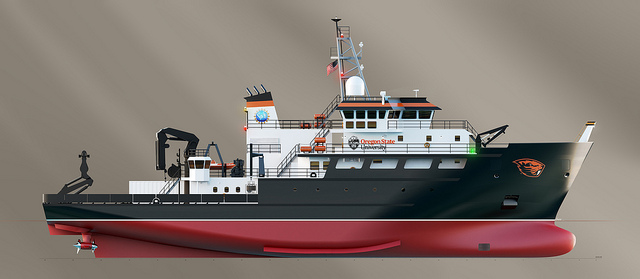Gulf Island Shipyards LLC, Houma, La., will build the first in a new series of regional-class oceanographic research vessels (RCRVs) for Oregon State University, funded with a $121.88 million grant from the National Science Foundation.
The 193’x41’ OSU vessel will be the first of three planned for the Pacific, Atlantic and Gulf of Mexico coasts. NSF chose OSU in 2013 to be the lead institution on the project for planning and selecting a shipyard. When the next two ships are funded, the total grant could increase to as much as $365 million.
The building program had some shaky times in Congress, when it looked like it could stall in the House of Representatives. But the project had stronger support in the Senate, and now plans call for laying the first keel in 2018 for a 2020 delivery and yearlong testing program. The follow-on vessels would be delivered in 2021 and 2022. The first ship will focus on missions in West Coast and Alaska waters when its research voyages start in fall 2021.
“There will be a full year of testing because there are many interconnected systems to try out,” according to Demian Bailey of OSU, a co-leader of the RCRV project. “Any new ship needs to have shakedown cruises, but we’ll have to test all of the scientific instrumentation as well, from the acoustic multibeam seafloor mapping system to its seawater and meteorological data collection, processing and transfer capabilities.
“These ships will be very forward-looking and are expected to support science operations for 40 years or longer. They will be the most advanced ships of their kind in the country.”
The NSF later this year will begin a competitive selection of institutions to operate the second and third vessels, most likely to be universities or research consortiums.
The ships are a long-sought addition to the U.S. Academic Research Fleet, which is aging and in need of more modern, multimission vessels. They will be accepted after their first year of testing and certification by the University-National Oceanographic Laboratory System (UNOLS), which coordinates operations of research ships owned by the NSF, Navy and institutions.
The next-generation class will include capabilities for detailed seafloor mapping — an important mission for the West Coast vessel, to help understand geologic structures and processes such as the Cascadia subduction zone, which puts the Northwest at high risk for earthquakes and tsunamis, OSU officials said.
Algae blooms, changing ocean chemistry, and interactions between the sea and atmosphere will be targets of the ships’ sensors. The communications package will include high bandwidth satellite links, for streaming data and video to scientists on land.
Other capabilities will include deploying coring equipment, tethered and autonomous underwater vehicles, and UAVs.
With a cruising speed of 11.5 knots and a 7,000-mile range, the RCRVs will have at least 21 days endurance at sea, with 16 berths for researchers and 13 for crew.
“This class of ships will enable researchers to work much more safely and efficiently at sea because of better handling and stability, more capacity for instrumentation and less noise,” said Clare Reimers, a professor in the OSU College of Earth, Ocean and Atmospheric Science and a RCRV project co-leader.
The design also has numerous “green” features promoting energy efficiency and lower emissions, “including an optimized hull form, waste heat recovery, LED lighting, and variable speed power generation,” said Reimers.
OSU previously operated the 184’ research vessel Wecoma from 1975 until it was retired in 2012, and then took over operation of a sister ship, the Oceanus, that had been based with the Woods Hole Oceanographic Institution in Massachusetts. The Oceanus will in turn be retired when the first new RCRV becomes fully operational in 2021.





